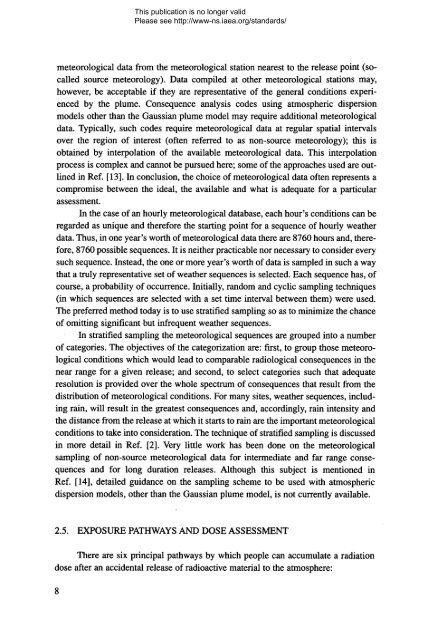LEVEL 3 - gnssn - International Atomic Energy Agency
LEVEL 3 - gnssn - International Atomic Energy Agency
LEVEL 3 - gnssn - International Atomic Energy Agency
You also want an ePaper? Increase the reach of your titles
YUMPU automatically turns print PDFs into web optimized ePapers that Google loves.
This publication is no longer valid<br />
Please see http://www-ns.iaea.org/standards/<br />
meteorological data from the meteorological station nearest to the release point (socalled<br />
source meteorology). Data compiled at other meteorological stations may,<br />
however, be acceptable if they are representative of the general conditions experienced<br />
by the plume. Consequence analysis codes using atmospheric dispersion<br />
models other than the Gaussian plume model may require additional meteorological<br />
data. Typically, such codes require meteorological data at regular spatial intervals<br />
over the region of interest (often referred to as non-source meteorology); this is<br />
obtained by interpolation of the available meteorological data. This interpolation<br />
process is complex and cannot be pursued here; some of the approaches used are outlined<br />
in Ref. [13]. In conclusion, the choice of meteorological data often represents a<br />
compromise between the ideal, the available and what is adequate for a particular<br />
assessment.<br />
In the case of an hourly meteorological database, each hour’s conditions can be<br />
regarded as unique and therefore the starting point for a sequence of hourly weather<br />
data. Thus, in one year’s worth of meteorological data there are 8760 hours and, therefore,<br />
8760 possible sequences. It is neither practicable nor necessary to consider every<br />
such sequence. Instead, the one or more year’s worth of data is sampled in such a way<br />
that a truly representative set of weather sequences is selected. Each sequence has, of<br />
course, a probability of occurrence. Initially, random and cyclic sampling techniques<br />
(in which sequences are selected with a set time interval between them) were used.<br />
The preferred method today is to use stratified sampling so as to minimize the chance<br />
of omitting significant but infrequent weather sequences.<br />
In stratified sampling the meteorological sequences are grouped into a number<br />
of categories. The objectives of the categorization are: first, to group those meteorological<br />
conditions which would lead to comparable radiological consequences in the<br />
near range for a given release; and second, to select categories such that adequate<br />
resolution is provided over the whole spectrum of consequences that result from the<br />
distribution of meteorological conditions. For many sites, weather sequences, including<br />
rain, will result in the greatest consequences and, accordingly, rain intensity and<br />
the distance from the release at which it starts to rain are the important meteorological<br />
conditions to take into consideration. The technique of stratified sampling is discussed<br />
in more detail in Ref. [2]. Very little work has been done on the meteorological<br />
sampling of non-source meteorological data for intermediate and far range consequences<br />
and for long duration releases. Although this subject is mentioned in<br />
Ref. [14], detailed guidance on the sampling scheme to be used with atmospheric<br />
dispersion models, other than the Gaussian plume model, is not currently available.<br />
2.5. EXPOSURE PATHWAYS AND DOSE ASSESSMENT<br />
There are six principal pathways by which people can accumulate a radiation<br />
dose after an accidental release of radioactive material to the atmosphere:

















